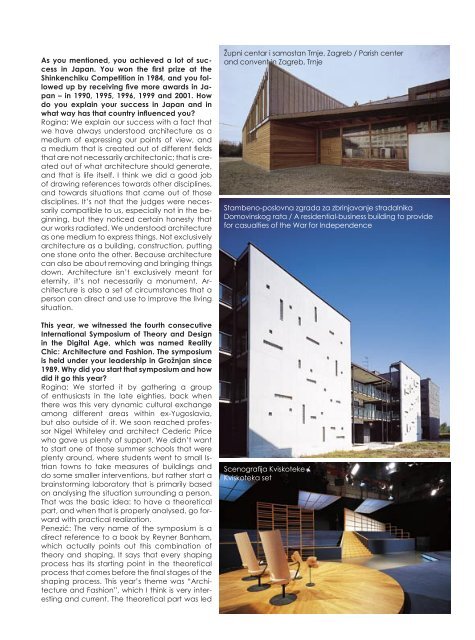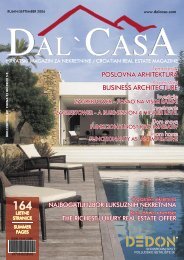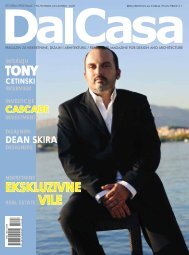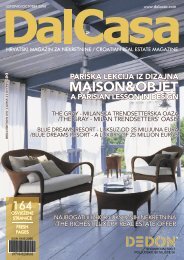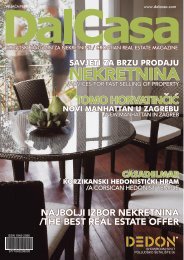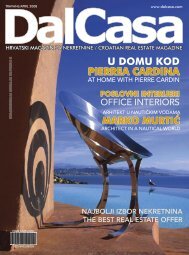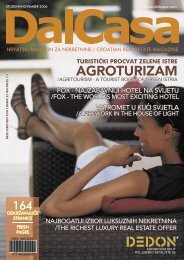100% DESIGN LONDON - DalCasa
100% DESIGN LONDON - DalCasa
100% DESIGN LONDON - DalCasa
You also want an ePaper? Increase the reach of your titles
YUMPU automatically turns print PDFs into web optimized ePapers that Google loves.
As you mentioned, you achieved a lot of success<br />
in Japan. You won the first prize at the<br />
Shinkenchiku Competition in 1984, and you followed<br />
up by receiving five more awards in Japan<br />
– in 1990, 1995, 1996, 1999 and 2001. How<br />
do you explain your success in Japan and in<br />
what way has that country influenced you<br />
Rogina: We explain our success with a fact that<br />
we have always understood architecture as a<br />
medium of expressing our points of view, and<br />
a medium that is created out of different fields<br />
that are not necessarily architectonic; that is created<br />
out of what architecture should generate,<br />
and that is life itself. I think we did a good job<br />
of drawing references towards other disciplines,<br />
and towards situations that came out of those<br />
disciplines. It’s not that the judges were necessarily<br />
compatible to us, especially not in the beginning,<br />
but they noticed certain honesty that<br />
our works radiated. We understood architecture<br />
as one medium to express things. Not exclusively<br />
architecture as a building, construction, putting<br />
one stone onto the other. Because architecture<br />
can also be about removing and bringing things<br />
down. Architecture isn’t exclusively meant for<br />
eternity, it’s not necessarily a monument. Architecture<br />
is also a set of circumstances that a<br />
person can direct and use to improve the living<br />
situation.<br />
Župni centar i samostan Trnje, Zagreb / Parish center<br />
and convent in Zagreb, Trnje<br />
Stambeno-poslovna zgrada za zbrinjavanje stradalnika<br />
Domovinskog rata / A residential-business building to provide<br />
for casualties of the War for Independence<br />
This year, we witnessed the fourth consecutive<br />
International Symposium of Theory and Design<br />
in the Digital Age, which was named Reality<br />
Chic: Architecture and Fashion. The symposium<br />
is held under your leadership in Grožnjan since<br />
1989. Why did you start that symposium and how<br />
did it go this year<br />
Rogina: We started it by gathering a group<br />
of enthusiasts in the late eighties, back when<br />
there was this very dynamic cultural exchange<br />
among different areas within ex-Yugoslavia,<br />
but also outside of it. We soon reached professor<br />
Nigel Whiteley and architect Cederic Price<br />
who gave us plenty of support. We didn’t want<br />
to start one of those summer schools that were<br />
plenty around, where students went to small Istrian<br />
towns to take measures of buildings and<br />
do some smaller interventions, but rather start a<br />
brainstorming laboratory that is primarily based<br />
on analysing the situation surrounding a person.<br />
That was the basic idea: to have a theoretical<br />
part, and when that is properly analysed, go forward<br />
with practical realization.<br />
Penezić: The very name of the symposium is a<br />
direct reference to a book by Reyner Banham,<br />
which actually points out this combination of<br />
theory and shaping. It says that every shaping<br />
process has its starting point in the theoretical<br />
process that comes before the final stages of the<br />
shaping process. This year’s theme was “Architecture<br />
and Fashion”, which I think is very interesting<br />
and current. The theoretical part was led<br />
Scenografija Kviskoteke /<br />
Kviskoteka set<br />
29


